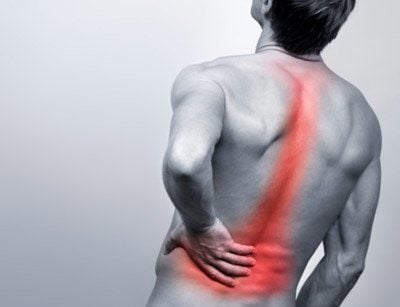This is an automatically translated article.
Sciatica occurs mainly due to diseases of the spine, or injury to the sciatic nerve. It occurs commonly at a rate of 40% in all ages. The disease can relieve symptoms in various ways such as exercise, medication, physical therapy, etc.1. What is sciatica?
The sciatic nerve begins in the spinal cord, runs through the hips and buttocks, and then branches down each leg.
The sciatic nerve is the longest and one of the most important nerves in the body. It directly affects the control and feel of the feet. When the sciatic nerve is irritated, you experience sciatica.
Sciatica produces moderate to severe pain in the back, buttocks, and legs and feels weak or numb in these areas.
Sciatica mainly occurs due to trauma to the sciatic nerve or to an area that affects the sciatic nerve such as the vertebrae, neck bones or back bones.
Sciatica is quite common, up to 40% of people will have it at some point in their life and become more frequent in old age.
2. Symptoms
Sciatica has typical symptoms because it is the result of injury or damage to the sciatic nerve. Usually, if you feel pain from the back through the buttocks to the lower extremities, then there is a high risk of sciatica. In addition, it can cause other symptoms such as:
Pain that gets stronger with movement Numbness or weakness in the legs or feet along the sciatic nerve. In severe cases there may be loss of sensation or movement. Tingling sensation, accompanied by sharp pain in the toes or feet. Urinary incontinence. This is a rare symptom of cauda equina syndrome (CES), which is a dangerous syndrome that requires immediate medical attention.
3. Cause
Sciatica can be caused by spinal conditions, trauma, or spinal or sciatic nerve tumors. Here are some of the most common causes of sciatica :
Herniated disc : A herniated disc is a condition in which the cartilage that separates the vertebrae is torn, causing fluid to leak out, which can cause compresses the sciatic nerve, leading to pain and numbness in the lower extremities. An estimated 5% of people experience sciatica due to a herniated disc at some point in their life. Spinal stenosis: Spinal stenosis, also known as lumbar spinal stenosis, is characterized by a narrowing of the spinal canal that puts increased pressure on the spinal cord and sciatic nerve roots, causing sciatica. Spondylolisthesis: Spondylolisthesis is a consequence of disc herniation. When one vertebra is stretched forward relative to the others, that elongated vertebra can compress the sciatic nerve root. Piriformis syndrome: Piriformis syndrome is a rare neuromuscular disorder in which the piriformis muscle contracts or contracts involuntarily, causing sciatica. The piriformis muscle is the muscle that connects the lower part of the spine to the thighbone. When it tightens, it can put pressure on the sciatic nerve, leading to sciatica. Piriformis syndrome can be aggravated by prolonged sitting, falling, or being in a car accident.

Thoát vị đĩa đệm là một trong các nguyên nhân gây đau thần kinh tọa
4. Risk factors
Several factors can increase your risk of developing sciatica, the most common of which include:
Age, as it's more likely to have worn parts and injuries Occupation causes causes back pain such as heavy lifting, prolonged sitting or twisting movements Diabetes increases the risk of nerve damage Smoking can cause the outer layer of spinal discs to tear. Patients should seek medical attention immediately if you experience the following symptoms:
The pain occurs after a serious injury or accident. Sudden, severe pain in the lower back or leg combined with numbness or muscle weakness in that leg. Inability to control bladder or bowels, which are symptoms of cauda equina syndrome. Cauda equina syndrome
In rare cases, a herniated disc can press on nerves causing you to lose control of your bowels or bladder, a condition known as cauda equina syndrome.
It can also cause numbness or tingling in the groin area, decreased sex drive, and paralysis if left untreated.
Cauda equina syndrome usually develops slowly. It is important to seek medical attention immediately when symptoms appear:
Bladder or bowel incontinence, which can lead to urinary incontinence or retention of waste Pain in one or both legs Numbness in one leg or both legs Weakness in one or both legs, making it difficult to get up after sitting Stumbling when trying to get up Visible progress or sudden loss of sensation in the lower body, including the mid-legs, buttocks, inner thighs, heels, and the entire foot. MORE: Do young people suffer from sciatica?
5. Diagnosis
Symptoms of sciatica are different from person to person depending on the cause. To diagnose sciatica, you may be asked by your doctor about your medical history (have you had any recent injuries, where and how it feels, what you do to relieve the pain, what causes the pain to intensify, when and under what circumstances the pain started, etc.).
After asking about the illness, you may be given a physical exam by your doctor, including testing your strength and muscle reflexes, performing some stretching and moving exercises to determine how the movement is causing the pain. more pain.
For people who have been treated for sciatica for more than 1 month or have serious diseases such as cancer, additional neurological tests are needed. They allow the nerve impulses to be examined and abnormalities found, helping to determine the location involved and the extent to which the impulse is slowed.
Imaging tests allow the doctor to look at abnormalities in the spine, which helps determine the cause of sciatica.
The most common imaging tests used to diagnose sciatica are spinal X-rays, MRIs, and CT scans. A normal X-ray will not be able to provide a view of sciatic nerve damage. In this case, the doctor may order a CT scan of the spinal cord to get a clearer picture of the spinal cord and nerves.

Bác sĩ sẽ hỏi về tính chất cơn đau thần kinh tọa trong khi thăm khám
6. Treatment
Once sciatica is diagnosed, your doctor may recommend that you resume your daily activities, avoiding bed or activities that could make the condition worse.
Some home treatments that may be effective in treating sciatica include:
Ice: Apply ice or a bag of frozen vegetables to a towel and apply to the painful area for 20 minutes a day, several times per day for the first few days of pain to reduce swelling and pain. Warm compress: Apply with a hot pack or heating pad. For the first few days, apply a cold compress to reduce swelling. After 2-3 days, switch to warm compresses. If pain continues, try alternating between cold and warm compresses. Stretching: Gently stretching the lower back can help with sciatica. Learn how to stretch properly by taking a physical therapy course. Medication: Over-the-counter medications, such as aspirin and ibuprofen, can also help reduce pain, inflammation, and swelling. Be careful when using aspirin, as it can cause complications such as bleeding and stomach ulcers. Exercise regularly: The more active you are, the more endorphins your body releases. Endorphins are pain relievers secreted by the body. At first, do low-impact activities like swimming and biking. Then gradually increase according to the degree of improvement of the disease. Physical therapy: Physical therapy exercises can help improve posture and strengthen back muscles. Prescription medications: Muscle relaxants, pain relievers, or antidepressants may be prescribed in the treatment of sciatica. Epidural steroid injection: Corticosteroid medicine is injected into an area called the epidural space, which is the tube that surrounds the spinal cord. However, it can cause many serious side effects, so epidural steroid injections are limited to certain medical facilities. Surgery: Used by people with severe pain or loss of bowel and bladder control or weakness in certain muscle groups of the lower extremities. Alternative Treatments: In growing popularity. Examples include acupuncture, hypnosis, massage, etc.
7. Precautions
Prevent sciatica or sciatica recurrence in the following ways:
Exercise regularly: Strengthening your back and abdominal or spinal muscles is key to maintaining a healthy back. Pay attention to posture: Make sure that the chair is suitable to keep your back in good posture, place your feet on the floor when sitting, and use the armrests. How to move: Lift weights appropriately, by bending your knees and keeping your back straight. Sciatica occurs mainly due to diseases of the spine, or injury to the sciatic nerve. The disease can reduce symptoms by taking medicine and changing the diet,....
Please dial HOTLINE for more information or register for an appointment HERE. Download MyVinmec app to make appointments faster and to manage your bookings easily.
Reference source: healthline.com













